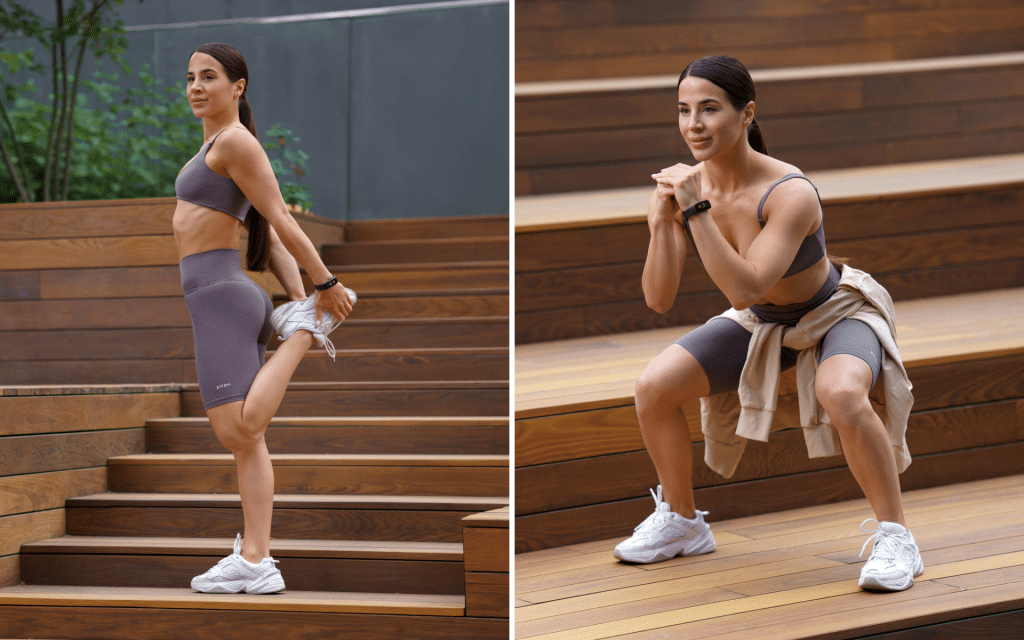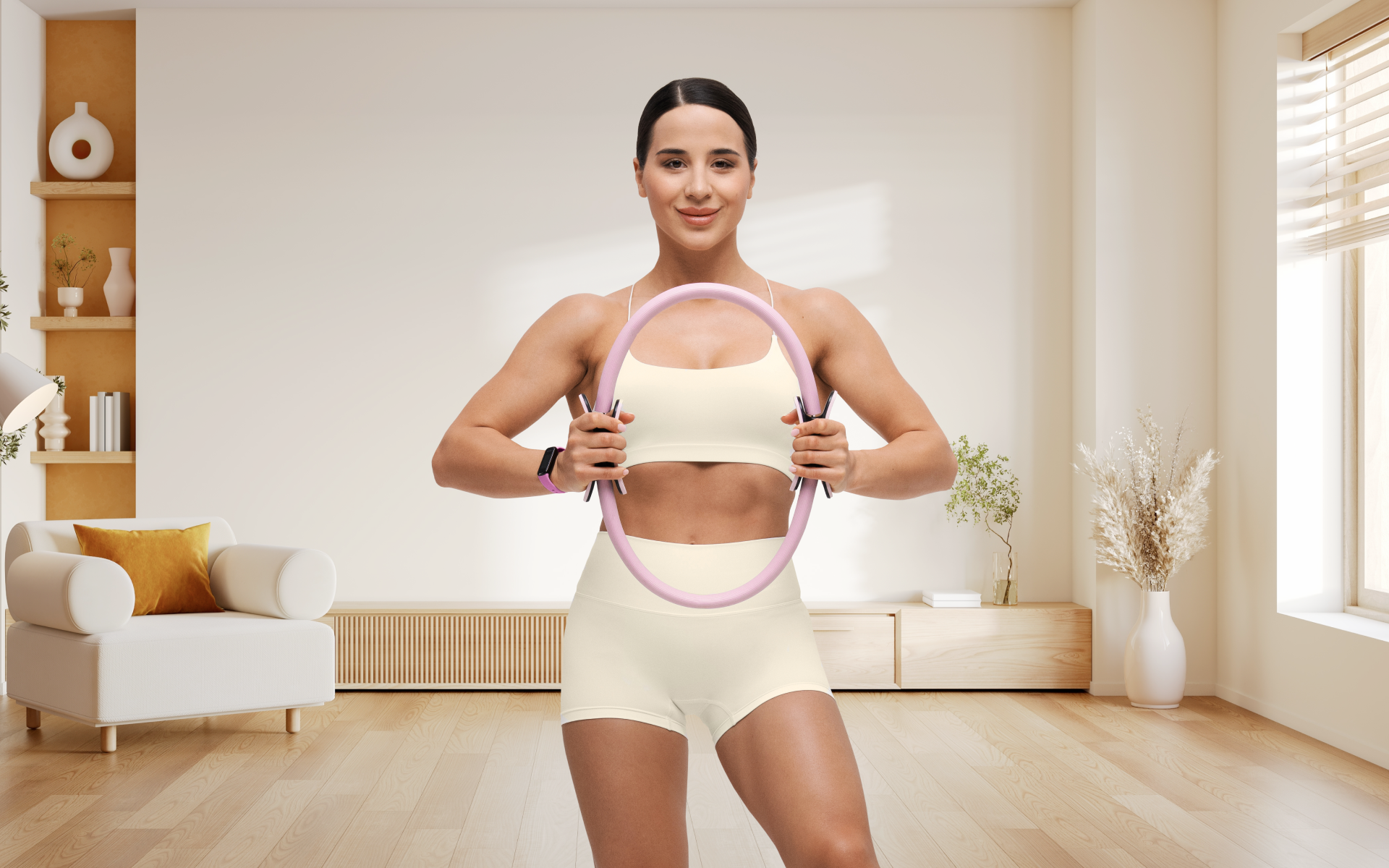Endomorphs are one of 3 somatotypes, or body types, popularized in the mid-20th century. They describe a naturally curvier build, with a tendency to store more body fat compared to other body types, such as ectomorphs (typically leaner) or mesomorphs (more muscular) (1).
At first glance, this article might sound like a handy roadmap for building a workout plan, but there’s more to it.
Here’s the thing—experts now acknowledge that somatotypes are an oversimplification.
While some traits might loosely align with these categories, research shows that various factors influence:
- Body composition
- Metabolism
- Fitness potential (2).
Genetics, lifestyle, diet, and consistency play a more decisive role than a label like “endomorph.” Plus, people rarely fit neatly into one type, so the lines are blurrier than they seem.
But don’t worry. That doesn’t mean this information is useless.
This description can provide a starting point if you can relate to it.
Think of it as a guideline rather than a rulebook.
Here’s how to make the most of this information when designing an endomorph diet and workout plan female-focused (plus, a sample workout plan for endomorphs):
How Do Female Endomorphs Lose Weight?
Weight loss for anyone, including those identifying as an “endomorph,” boils down to a few proven, science-based principles.
1. Create A Calorie Deficit
One of the most effective ways to lose weight is to be in a calorie deficit.
This deficit means consuming fewer calories than your body needs to maintain weight.
When your body doesn’t get enough calories from food to fuel daily activities, it uses stored energy (like fat) as fuel.
However, this doesn’t mean you must starve yourself. A moderate calorie deficit, typically 300–500 calories less per day, is a sustainable way to lose weight without compromising energy levels or muscle mass (3).
Try tracking your food intake using an app or journal to get an accurate picture of how much you’re eating and where you could make small changes.
Our previous article on metabolic confusion for endomorphs sheds light on how varying calorie intake can enhance metabolism.
2. Focus On Whole, Nutrient-Dense Foods
What you eat matters just as much as how much you eat.
Prioritize whole, minimally processed foods. These are richer in nutrients, fiber, and protein, which help you stay full longer while fueling your body.
- Lean proteins: Chicken, fish, tofu, and eggs boost metabolism and help preserve muscle during weight loss (4).
- High-fiber foods: Vegetables, fruits, legumes, and whole grains can satisfy cravings and support healthy digestion.
- Healthy fats: From sources like nuts, seeds, avocado, and olive oil are great for overall health in small portions.
3. Strength Training Is Key
Many believe cardio is the ultimate calorie burner, but strength training is crucial in weight loss.
Building muscle helps increase your basal metabolic rate (BMR)—how many calories your body burns at rest. Essentially, the more muscle you have, the more calories your body will burn throughout the day (5).
Aim for at least 2-3 strength-training sessions per week.
Focus on compound exercises, like squats, deadlifts, push-ups, and rows.
These compound movements target multiple muscle groups simultaneously, giving you the most bang for your buck.
4. Don’t Skip Cardio (But Don’t Overdo It)
While it’s not the show’s star, cardio can support your weight loss goals.
Activities like brisk walking, cycling, or swimming help burn additional calories and improve cardiovascular health.
A combination of steady-state cardio (consistent intensity) and high-intensity interval training (HIIT) is a great choice (6). Keep it to 2–3 weekly sessions to avoid overtraining and ensure you have enough energy for strength training.
Reasons why BetterMe is a safe bet: a wide range of calorie-blasting workouts, finger-licking recipes, 24/7 support, challenges that’ll keep you on your best game, and that just scratches the surface! Start using our app and watch the magic happen.
5. Consistency Over Perfection
The most essential factor in weight loss? Consistency.
The daily small, sustainable actions add up over time (7).
Don’t get discouraged by occasional setbacks or expect overnight results.
Instead, focus on building habits you can use for the long haul.
6. Pay Attention To Recovery And Stress Management
Recovery and stress management are often overlooked but essential for weight loss (8).
Chronic stress can increase cortisol levels, a hormone that can make your body more likely to store fat, especially around the midsection (9)—practice activities like yoga, meditation, or relaxing.
Proper sleep is also crucial. Aim for 7–9 hours of quality sleep per night.
Sleep deprivation can affect your hunger hormones, making you more likely to overeat.
7. Be Patient With Progress
Weight loss is rarely linear. Some weeks, you might see a significant drop on the scale; other times, you might feel like nothing is happening.
That’s normal. Instead of obsessing over daily weigh-ins, track multiple markers of progress, like:
- How your clothes fit
- Your energy levels
- Your strength in the gym.
Read more: PR in Fitness: How to Achieve It
Should Endomorphs Lift Heavy Or Light?
Lifting heavy, light, or something in between all serves a purpose, depending on your goal.
The idea of tailoring your workouts purely to a somatotype, like “endomorph,” isn’t strongly supported by research. Instead, the key lies in understanding how different weightlifting approaches impact specific fitness goals.
For Building Strength, Lift Heavy
If you want to get stronger, lifting heavy weights is the way.
Strength training involves using weights that challenge you to lift closer to your maximum capacity. Typically, this means performing 3–6 repetitions per set with heavier loads (10).
These weights should feel challenging by the final rep while maintaining proper form.
Lifting heavy weights stimulates your central nervous system and helps build your body’s ability to exert force over time.
For example, lifts like squats, deadlifts, and bench presses are excellent for developing total-body strength. Focus on compound exercises (movements that engage multiple joints and muscles) to maximize your effort.
Remember to use progressive overload for continued progress. This principle means gradually increasing the weight or intensity over time to challenge your muscles.
It’s a proven method for getting stronger, regardless of body type (11).
For Muscle Growth, Use Moderate Weights
Muscle growth, or hypertrophy, refers to increasing the size of your muscle fibers.
Moderate weights are your best bet if you’re working toward a more defined or sculpted physique. Aim for 8–12 repetitions per set at a weight that makes the last few reps feel difficult but doable (10).
Hypertrophy training works best when paired with:
- A focus on form
- Controlled movements
- A mix of compound and isolation exercises.
For example, in addition to squats, you might add exercises like a leg curl to specifically target the quadriceps rather than the lower body as a whole.
For Endurance And Muscle Tone, Use Lighter Weights
Lighter weights and higher repetitions (usually 12–20+ per set) are ideal for improving muscular endurance (10). This approach tones muscles while also building stamina for everyday activities or sports.
However, lifting light doesn’t mean going easy. You should still challenge yourself by using a weight that feels tough by the end of the set. Pairing this with short rest periods between sets can keep your workouts efficient and engaging.
Combine Heavy And Light For Balanced Fitness
The best approach for most people is balancing heavy and light lifting, tailored to your goals.
For example:
- You might focus on heavier weights and low reps for lower-body strength (like squats)
- While incorporating lighter weights with higher reps for upper-body endurance (like triceps kickbacks).
This balance of heavy and light lifting keeps your routine well-rounded and prevents plateaus.
What Is The Best Exercise For An Endomorph Female?
The truth is, there’s no single “best” exercise for anyone, including endomorph females.
The most effective workout combines 3 elements:
- Strength Training: Building muscle boosts your metabolism and helps you lose fat (5). Focus on compound exercises like squats, deadlifts, and push-ups to target multiple muscle groups. Aim for 2–3 sessions per week.
- Cardio: Brisk walking, cycling, or swimming improves heart health and burns calories (6). Combine steady-state cardio with high-intensity interval training (HIIT) for variety and efficiency.
- Flexibility and Mobility Work: Yoga, stretching, or foam rolling can improve recovery, reduce stress, and support joint health, making your workouts more effective (12, 13, 14).
The best workout plan for endomorph female at home or gym is the one you can stick with consistently and enjoy. Mix and match to suit your fitness goals and lifestyle.
What Is The Best Workout Plan For Endomorph Females?
If you’re starting your fitness journey, a mix of strength training, cardio, and mobility work is your best bet. This plan balances all 3 to help you build strength, burn calories, and improve flexibility.
Here’s a beginner-friendly weekly workout routine:
Weekly Routine
- Day 1: Full-Body Strength Training + LISS Cardio (Optional)
- Day 2: LISS Cardio + Mobility Work
- Day 3: Full-Body Strength Training
- Day 4: Rest or Mobility Work
- Day 5: Full-Body Strength Training + LISS Cardio (Optional)
- Day 6: LISS Cardio + Mobility Work
- Day 7: Rest
Now, let’s break down a full-body workout plan for endomorph females involving strength workouts and mobility work.
For LISS (Low Intensity Steady State) cardio (e.g., walking steadily for 30–45 minutes), keep the intensity low enough to hold a conversation without gasping for air.
When it comes to weight loss, progress is made by inches, not miles, so it’s much harder to track and a lot easier to give up. The BetterMe: Health Coaching app is your personal trainer, nutritionist, and support system all in one. Start using our app to stay on track and hold yourself accountable!
Full-Body Strength Workout (6 Exercises)
Each exercise includes 2–3 sets of 8–12 reps.
Rest for 60–90 seconds between each set.
Squats (Bodyweight or Dumbbell)
- Stand with feet shoulder-width apart, toes slightly pointing out.
- Hold a dumbbell at chest height or keep hands clasped in front of you for bodyweight squats.
- Push your hips back, bend your knees, and lower your body as if sitting into a chair. Stop when thighs are parallel to the ground.
- Press through your heels to stand back up to the starting position.
Push-Ups (Modified or Standard)
- Start in a high plank position with hands slightly wider than shoulder-width.
- For a modified version, drop your knees to the floor.
- Lower your chest toward the ground by bending your elbows, keeping your body straight.
- Push back up to the starting position.
Bent-Over Rows (With Dumbbells)
- Hold a dumbbell in each hand, palms facing your body.
- Hinge at your hips, keeping your back straight and chest slightly lifted.
- Pull the dumbbells toward your waist, squeezing your shoulder blades together.
- Slowly lower the weights back to the starting position.
Plank Hold (Basic)
- Start on your hands and toes, creating a straight line from head to heels.
- Keep your core engaged and avoid letting your hips sag or rise too high.
- Breathe in through the chest and out through the stomach. Each breath out should tighten the core even further.
- Hold the position for 20–30 seconds, gradually increasing this time as you build strength.
Step-Ups (With Dumbbells Optional)
- Stand in front of a sturdy bench or step. Hold dumbbells if you’re ready for more resistance.
- Step onto the bench with one foot, pressing through your heel to lift your entire body.
- Step back down with the same foot and repeat with the other leg.
Glute Bridges
- Lie on your back with knees bent and feet flat, hip-width apart.
- Press your heels into the floor and lift your hips toward the ceiling.
- Squeeze your glutes at the top, then slowly lower back to the floor.
Mobility Work (3 Exercises)
Complete these mobility exercises for 5–8 minutes at the start or end of your workouts.
Cat-Cow Stretch
- Start on all fours, with hands under shoulders and knees under hips.
- On an inhale, arch your back by lifting your chest and tailbone (cow pose).
- On the exhale, round your spine, tucking your chin and pelvis (cat pose).
- Alternate between these positions for 6–8 slow breaths.
World’s Greatest Stretch
- Start in a high plank position with your body straight.
- Step your right foot outside your right hand. Drop your hips slightly toward the ground.
- Reach your right arm toward the ceiling, twisting your torso.
- Return your hand to the ground and step back into plank position.
- Switch sides and repeat.
Child’s Pose
- Kneel on the ground and sit back onto your heels.
- Reach your arms forward and lower your chest toward the ground.
- Breathe deeply, holding for 30–60 seconds.
Read more: Gym Workout Plan for Female Beginners
What Are 3 Secrets To Weight Loss For Endomorphs?
These aren’t secrets so much as proven, practical strategies:
- Create a Calorie Deficit: Endomorph body type weight loss happens when you burn more calories than you consume. Use a sustainable approach by reducing portion sizes and adding daily physical activity. Aim for 300–500 fewer calories a day rather than drastic cuts.
- Focus on Protein and Fiber: High-protein meals support muscle retention and keep you fuller longer. Adding fiber-rich foods, like vegetables, fruits, and whole grains, helps control hunger and improve digestion.
- Be Consistent with Strength Training: Building muscle increases your resting metabolism, meaning you’ll burn more calories even at rest.
Strength train 2–3 times a week, focusing on progressive overload (gradually increasing weights or reps).
Consistency, patience, and sticking to evidence-backed habits are your real “secrets.”
What Is The Best Diet Plan For An Endomorph?
The best diet plan isn’t about following strict rules but creating a sustainable, balanced approach that works for you.
Try these diet guidelines for the best results:
Prioritize Whole, Nutrient-Dense Foods
Focus on lean proteins, vegetables, fruits, whole grains, and healthy fats.
These foods are rich in nutrients and keep you satisfied.
Balance Macronutrients
Include protein, carbs, and fats in every meal. For example, pair grilled chicken (protein) with roasted sweet potatoes (carbs) and steamed broccoli with olive oil (fat).
Avoid Crash Diets and Over-Restriction
Drastic changes are hard to maintain and often lead to yo-yo dieting.
Instead, aim for steady progress by making small, sustainable adjustments that fit your lifestyle.
Hydration and mindful eating also play key roles. Listen to your hunger cues, eat slowly, and enjoy your meals with balance in mind.
Somatotypes are general body classifications and not fixed categories, so an endomorph cannot actually “become” a mesomorph. However, through consistent training, a balanced diet, and a healthy lifestyle, an endomorph can develop a muscular and leaner physique that many associate with mesomorphs. Yes, endomorphs can achieve a ripped appearance with the right approach. This approach includes a combination of strength training, maintaining a calorie deficit through mindful eating, and incorporating cardio. Building muscle and lowering body fat is achievable, but it may take more time and consistency due to natural tendency to store fat. This endomorph workout can optimize fat loss and build lean muscle efficiently, making it a good place to start. Endomorphs can develop visible abs if they reduce their overall body fat percentage. This body fat reduction involves strength training, especially targeting the core, maintaining a calorie deficit, and staying consistent with physical activity. Genetics also influences how and where fat is lost, so patience is key. While bone structure does influence overall body shape, endomorphs can still work toward an hourglass-like appearance by focusing on muscle development and fat reduction in specific areas. Strength training to build the glutes and shoulders, combined with core work and fat loss, can enhance curves and create the illusion of an hourglass figure. However, the extent to which this is achievable depends on individual genetics and natural proportions.Frequently Asked Questions
Can an endomorph become a mesomorph?
Can endomorphs be ripped?
Can endomorphs get abs?
Can endomorphs have an hourglass figure?
The Bottom Line
While being an “endomorph” might give you some clues about your body’s tendencies, your success depends on how consistently you apply these fundamental strategies.
Focus on eating balanced meals, staying active with strength and cardio training, and being kind to yourself on this health journey. Remember, sustainable progress always beats quick fixes.
DISCLAIMER:
This article is intended for general informational purposes only and does not serve to address individual circumstances. It is not a substitute for professional advice or help and should not be relied on for making any kind of decision-making. Any action taken as a direct or indirect result of the information in this article is entirely at your own risk and is your sole responsibility.
BetterMe, its content staff, and its medical advisors accept no responsibility for inaccuracies, errors, misstatements, inconsistencies, or omissions and specifically disclaim any liability, loss or risk, personal, professional or otherwise, which may be incurred as a consequence, directly or indirectly, of the use and/or application of any content.
You should always seek the advice of your physician or other qualified health provider with any questions you may have regarding a medical condition or your specific situation. Never disregard professional medical advice or delay seeking it because of BetterMe content. If you suspect or think you may have a medical emergency, call your doctor.
SOURCES:
- Sheldon’s Constitutional Theory: Somatotyping (2024, simplypsychology.org)
- Factors That Influence Body Weight (2003, ncbi.nlm.nih.gov)
- Calorie Deficit: What To Know (2022, health.clevelandclinic.org)
- Animal Protein versus Plant Protein in Supporting Lean Mass and Muscle Strength: A Systematic Review and Meta-Analysis of Randomized Controlled Trials (2021, mdpi.com)
- Increasing muscle mass to improve metabolism (2013, pmc.ncbi.nlm.nih.gov)
- Aerobic Exercise and Weight Loss in Adults (2024, jamanetwork.com)
- Consistent Exercise Timing as a Strategy to Increase Physical Activity: A Feasibility Study (2023, journals.lww.com)
- Impact of a stress management program on weight loss, mental health and lifestyle in adults with obesity: a randomized controlled trial (2018, pmc.ncbi.nlm.nih.gov)
- Obesity, Chronic Stress, and Stress Reduction (2023, pmc.ncbi.nlm.nih.gov)
- Loading Recommendations for Muscle Strength, Hypertrophy, and Local Endurance: A Re-Examination of the Repetition Continuum (2021, mdpi.com)
- Effects of Resistance Training Overload Progression Protocols on Strength and Muscle Mass (2024, pubmed.ncbi.nlm.nih.gov)
- Yoga as Part of Sports Medicine and Rehabilitation (2023, journals.lww.com)
- CURRENT CONCEPTS IN MUSCLE STRETCHING FOR EXERCISE AND REHABILITATION (2012, pmc.ncbi.nlm.nih.gov)
- A Meta-Analysis of the Effects of Foam Rolling on Performance and Recovery (2019, frontiersin.org)












